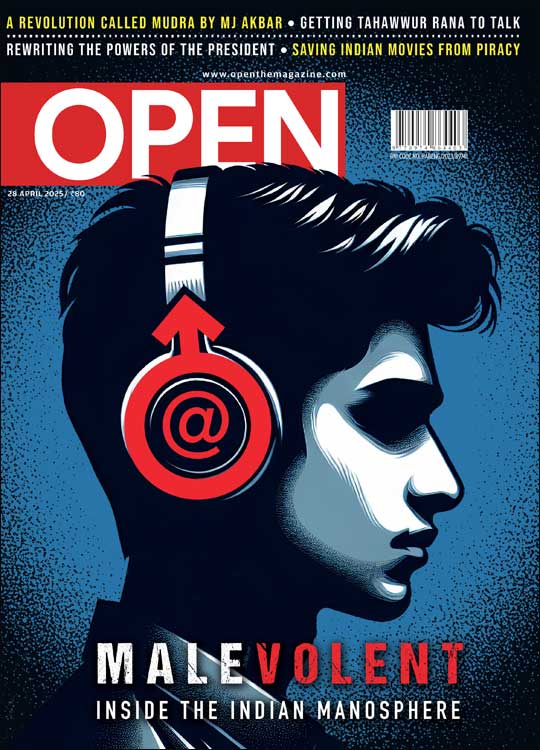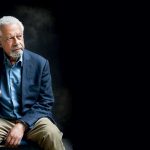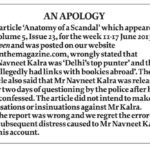Hanging by a Thread
Devinder Pal Singh Bhullar is on death row. The charges levelled against him under TADA don’t stick, but President Pratibha Patil has rejected his mercy petition anyway. Mercifully, not everyone is keeping quiet about this
 Shruti Ravindran
Shruti Ravindran
 Shruti Ravindran
|
07 Jul, 2011
Shruti Ravindran
|
07 Jul, 2011
/wp-content/uploads/2015/11/clemency1.jpg)
Devinder Pal Singh Bhullar is on death row. The charges levelled against him don’t stick, but President Pratibha Patil has rejected his mercy petition.
Navneet Kaur, wife of death row convict Devinder Pal Singh Bhullar, is courteous but wary, seated in her room at the Gurdwara Rakab Ganj in New Delhi. Clad in a lavender kurta patterned with grey and brown flowers, she tends to lose her gaze somewhere beyond the half-open door, a frown furrowing her forehead. But when she begins to speak, she looks squarely at you, in a daunting stare that seems to at once weigh you up and dismiss you. “I’m going to call these people,” she says, waving a newspaper article that referred to her husband as a ‘dreaded KLF (Khalistan Liberation Force) militant’, “and say, ‘Who told you he’s a militant?’ The police never found any weapon, any identification, any piece of paper. If he is proved guilty, if they find evidence, I’ll be the first to say ‘hang him’.”
That is the fate currently in store for Bhullar, after President Pratibha Patil summarily rejected his mercy petition on 25 May this year after an eight-year wait. He had been No. 18 on the list of mercy pleas, but Patil—and the Home Ministry—were evidently spurred into action by a writ petition that Bhullar’s wife, along with the Delhi Sikh Gurdwara Management Committee (DSGMC), had filed in the Supreme Court on 15 May, asking why his mercy petition had not been addressed since it was filed in January 2003. Navneet’s lawyer KTS Tulsi swiftly challenged the presidential order, saying the long torturous wait has made Bhullar mentally unsound, and that he cannot be hanged in such a state. This, along with the original petition, is likely to come up for hearing on 11 July.
For Navneet, it has been a long, lonely wait, filled with nothing but the endless paperwork of petitions and appeals for company. The wait began barely three months into her marriage to Bhullar, in December 1991. Then, a professor of mechanical engineering in Ludhiana’s Guru Nanak Engineering College, Bhullar was believed by the police to be connected to a remote-controlled bomb attack on the vehicle of a notoriously brutal SSP, Sumedh Singh Saini, credited with “finishing off” the Khalistani insurgency with former Punjab Police DGP KPS Gill. Navneet, for her part, maintains that the police came after him because they didn’t want him to “raise his voice” about the 42 college students who had gone missing.
According to the writ petition filed by Navneet and the DSGMC, the police raided Bhullar’s house following the attack, and when they didn’t find him, they “abducted his father and maternal uncle”, who were “tortured to death in police custody”. The petition adds that Bhullar’s engineer friend Balwant Singh Multani was “also abducted at the same time and detained in police custody by Saini… and tortured to death.” “They also picked up my dad,” recalls Navneet, “and released him after one-and-a-half months’ torture. They tied his hands, beat him with sticks, kept him in the cold, somewhere, with no FIR, no arrest.” She adds that the torture and detention left him “mentally disturbed, and barely capable of walking—the beatings had made his muscles loose”.
Bhullar went into hiding, and Navneet took on a job as a hostel warden in a private school in Bhatinda to get her mind off the turmoil. They never dared meet in between—“[If] he came to see me, they’d shoot him,” says Navneet, “that time, they shot youngsters and got stars.” Saini, for instance, earned himself a gallantry award in 1987.
On 11 September 1993, the cavalcade of the then Youth Congress President MS Bitta was hit by a remote-controlled blast, leaving 12 people dead. The Delhi Police conjectured that the blast was similar to the attack against Saini, and began to look for Bhullar as well. In 1994, Bhullar and his wife arranged to move to Vancouver, Canada, “to have a peaceful life”. Navneet went ahead, and Bhullar was caught with false papers while he was changing planes in Frankfurt, remained briefly in custody, and was deported to India in January 1995. The extradition was judged illegal two years later by a Frankfurt court.
He was tried for minor passport offences, and then, in a Delhi trial court, under the draconian Terrorist & Disruptive Activities Act (TADA), which lapsed later that year. His co-accused in the case, Daya Singh Lahoria, who was extradited from the US on condition that he wouldn’t be tried under TADA, was acquitted for lack of evidence. Bhullar wasn’t so lucky. Under TADA, acts of terrorism attracted a mandatory death sentence, and induced confessions were admissible as evidence. And that was all the Delhi Police had against Bhullar—a thumb imprint and signature on a confessional statement, which he later retracted in court.
Yet, despite the lack of any eyewitnesses or evidence pinning him to his alleged misdeeds, Bhullar was sentenced to death under TADA by a Delhi trial court in August 2001. Later that year, he appealed unsuccessfully against the conviction, though the three-judge bench could not reach a unanimous verdict. One of the judges, Justice MB Shah, held that Bhullar could not be convicted on the basis of a “dubious confession”, let alone given a death sentence, and recommended that he be acquitted. But Shah was overruled by the other two judges, who awarded the death penalty despite Shah’s dissenting opinion. “It’s the first case in the world,” points out Tulsi, “in which a death sentence has been given despite a difference of opinion among the judges. Even room for 1 per cent doubt cannot be called ‘the rarest of rare’ cases, and here there was 33 per cent uncertainty.”
According to a 2008 Amnesty International report on Supreme Court judgments on the death penalty, the majority judges ‘waxed eloquent about the need to combat the ‘menace of terrorism’, which was a matter of ‘international concern’.’ The judgment also refers to 9/11— though the Delhi blast took place on a 9/11 six years prior to the one that made the date infamous. It also referred to the December 2001 attack on the Indian Parliament, which took place while the appeal was being heard.
Since 2003, as successive Presidents dawdled over his mercy plea, Bhullar has remained in solitary confinement in Tihar’s jail No. 3. “He’s in an 8 x 10 [f00t] cell, with the toilet, bed, all in the same place,” says Navneet. “This room [her Rakab Ganj quarters] is very clean, but I feel even this is not so good. He was raised in a good family, so delicate, his mother and aunt tell me he never used to go out in the sunshine. And he has to face all this.”
The years of waiting on death row have taken their toll. Supreme Court judgments commuting death sentences to life imprisonment have cited the “brooding horror of hanging” and the “unique mental anguish and suffering” that is termed “death row syndrome”. While as a young under-trial, Bhullar was even interested in pursuing an MBA from jail—a request that was rejected—his 5,700 days in limbo have sapped him of all hope and the will to live. They have also reduced him to a state of infirmity that belies his 46 years of age. His wife says he now looks closer to 60, and his medical records from the past few years speak of numerous health complaints, including chest pain, shortness of breath, heaviness of chest, numbness of neck, and depression. “It’s all 99 per cent stress,” adds Navneet. “Under the death sentence, he is dying every day!”
Since last December, Bhullar has been admitted to the Institute of Human Behaviour and Allied Sciences (IHBAS) in east Delhi. “He came in with severe depression with suicide risk,” says IHBAS director, Dr Nimesh Desai. “His condition has only worsened, despite our best efforts.” Desai describes him as “dishevelled, negligent of his health care, suicidal in thought and intent” and incapable of speaking, “because of high despondency”. He is also indifferent to suggestions of activities intended to make him “feel better”. “When we say, ‘TV dekhiye, logon se miliye,’ he tells us, ‘Why? What’s the point?’” says Desai. “His reaction is understandable. What the hell does one say to such a person? What message of hope can there be?”
His lawyer as of the past two months, KTS Tulsi, says Bhullar seemed fragile when he went to visit him at the IHBAS psychiatric ward a month ago. “He kept telling me, ‘Main attvaadi nahi haan, attvaad de khilaaf haan.’ (‘I’m not a terrorist, I’m opposed to terrorism.’)” Upkar Kaur, his 75-year-old mother, says he is now so disoriented he can barely tell who she is. “Ab unka dimaag hi thheek nahin hai, bolta nahin hai, pehchanta nahin hai, ki yeh meri mother hai,” she says. “Yeh bilkul galat baat hai. Mera beta padha-likha hai, mechanical engineer hai, criminal mind nahi hai mera bachcha.” (He is not mentally sound, he doesn’t speak or know that I’m his mother. My son is no criminal, he is an educated man.)
For Upkar, who now lives in Sacramento, California, with her younger son, the verdict is tragedy twice over. Twenty years after her husband was tortured and killed, justice has still not been served. “Ek innocent ko buri tarah maarna, cruelty se maarna… He never so much as hurt a dog, and they jumped on his stomach, threw him down three floors…” she says, adding that whoever did this, “Woh parmaatma se bhugtega zaroor (The Lord will make them pay).”
Saini, incidentally, is currently facing charges of kidnapping, torture and murder, which the CBI filed against him after the Chandigarh High Court directed them to do so in 2008. Meanwhile, the case he foisted on Bhullar, accusing him of attempt to murder and attempt of terrorism fell apart in 2006, due to lack of evidence.
This is of no consolation to Navneet. For the past month, she has abandoned her aged parents and her job as a nurse in a Vancouver general hospital, to be in Delhi, where every day, she shuttles between Bhullar’s hospital and every embassy and human rights NGO she can think of. The effort has not been in vain. Last month, the European Union and the German ambassador to India wrote to the Home Minister, opposing Bhullar’s execution, and stressing that his extradition in 1995 was illegal.
Sikh groups like the SGPC and political parties, including the Shiromani Akali Dal and the opposition Congress in Punjab, have been rallying to Navneet’s side, asking the Prime Minister to grant Bhullar clemency. On 20 June, Navneet and her mother-in-law accompanied a 21-member delegation from a rally in Amb Sahib Gurdwara, Mohali, to submit a memorandum appealing to the Punjab Governor to intervene. On the same day, Sikh groups around the world, in Berlin, Holland and Vancouver, staged protests at their respective Indian embassies. “Sikh people, we have our differences,” Navneet says, “but we’re all united on this issue.”
Around the same time, the Save Bhullar campaign went viral on social networking sites, with the Sikh diaspora changing their profile pictures to its symbolic image—a picture of a poignantly youthful, well-groomed Bhullar in a pastel pink shirt and matching turban, with a noose hovering ominously before him. The same image spread across Punjab, through T-shirts, which were sold outside the Golden Temple in Amritsar, right alongside posters depicting Jarnail Singh Bhindranwale.
At the press conference convened by the DSGPC at the Gurdwara Rakab Ganj in Delhi on 2 July, references to militancy are entirely absent, though there is a faint spirit-scented air of sacrifice about the Sikh youth groups in a corner, who are donating blood to inscribe sanguineous petitions to the President. DSGPC president Paramjit Singh Sarna informs the crowd that he would deliver these to the President and the Home Minister, along with 125 more blood-signatures from youth groups in Ludhiana, as well as a hefty file containing the signatures of 40,000 Sikhs in Vancouver. Navneet then addresses the gathering. “I’ve been waiting for 20 years. I’ve had no justice. I’ve had mental torture,” she says, in a voice that rises to an inaudible gasp with every sentence.
Afterward, as the crowd crams their plates with rice under a tent leaking rainwater, Navneet says, “I had a very good life before marriage. People who see me now say, ‘She was one of the happiest girls in our family.’” Her voice falters when she thinks of that happy girl whose dreams were destroyed, as much as it does for the husband she prepares to see in a psychiatric ward—the defeated shell of the “intelligent, soft-spoken” man she knew 20 long years ago.
About The Author
CURRENT ISSUE
MOst Popular
3

/wp-content/uploads/2025/04/Cover-Manosphere.jpg)











More Columns
‘Colonialism Is a Kind of Theft,’ says Abdulrazak Gurnah Nandini Nair
Bill Aitken (1934 – 2025): Man of the Mountains Nandini Nair
The Pink Office Saumyaa Vohra